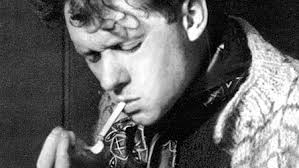 |
| Dylan Thomas 1914 - 1953 |
Do Not Go Gentle Into That Good Night by Dylan Thomas
Do not go gentle into that good night,
Old age should burn and rave at close of day;
Rage, rage against the dying of the light.
Though wise men at their end know dark is right,
Because their words had forked no lightning they
Do not go gentle into that good night.
Good men, the last wave by, crying how bright
Their frail deeds might have danced in a green bay,
Rage, rage against the dying of the light.
Wild men who caught and sang the sun in flight,
And learn, too late, they grieved it on its way,
Do not go gentle into that good night.
Grave men, near death, who see with blinding sight
Blind eyes could blaze like meteors and be gay,
Rage, rage against the dying of the light.
And you, my father, there on that sad height,
Curse, bless, me now with your fierce tears, I pray.
Do not go gentle into that good night.
Rage, rage against the dying of the light.
The form of this poem is known as a vilanelle; a strict format with nineteen lines - five tercets (three lines) followed by a final quatrain of four lines. Notice that each stanza has the same ABA rhyming scheme.
The lines 'Do not go gentle into that good night' and 'Rage, rage against the dying of the light' have become iconic in their own right. The influence of this poem has become widespread since it's publication. It is an exhortation to resist the onset of death, written as his own father was dying. The poet gives the examples of how 'wise men', 'good men', 'wild men' and 'grave men' do not meekly accept the inevitable.
Television writers have borrowed deeply from the poem including Doctor Who, Northern Exposure, Mad Men and Family Guy. The poem's connotation with death and endings was used to effect in the final episodes of St. Elsewhere and Roseanne.
As well as taking his name from Dylan Thomas, Bob Dylan was hugely influenced by his writing style and developed Thomas's themes of conflict in his own lyric writing.